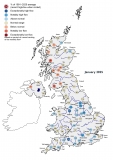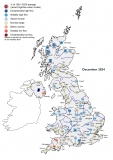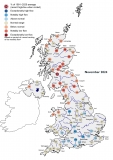Submitted by Steve Turner on
July was characterised by exceptional warmth and dryness, despite some unsettled spells, particularly in the north and west. It was the fourth hottest July for England (in a record from 1884) and exceptionally hot at times, particularly mid-month when a southerly airmass brought heatwave conditions, triggering a first Met Office red weather warning for extreme heat. Widespread record-breaking maximum temperatures followed, including a new maximum temperature record for the UK (40.3°C for Coningsby, Lincs, on the 19th). Widespread impacts were reported, with the hot temperatures and dry soils leading to wildfires, including fires that destroyed properties in London. Given the sustained hot, dry conditions, soil moisture and river flows receded sharply to exceptionally low levels across large areas of the country. Reservoir levels also declined, resulting in the lowest end-of-July stocks on record (from 1990) for England & Wales – many reservoirs saw stocks over 20% below average (e.g. 28% below at Elan Valley and Derwent Valley, 34% below at Colliford). The overall water resources situation in parts of south-east England was bolstered by a more favourable groundwater position, but groundwater resources also declined rapidly through the month. Given the continued deterioration in the water resources situation, in late July temporary use bans were announced (to commence in August) by several water companies in southern England. With hot, dry weather continuing in early August, water resource concerns continue to mount – the current Hydrological Outlook indicates a continuation of below normal river flows and groundwater levels over coming months, and exceptional late summer/early autumn rainfall will be needed to return to normal conditions.



